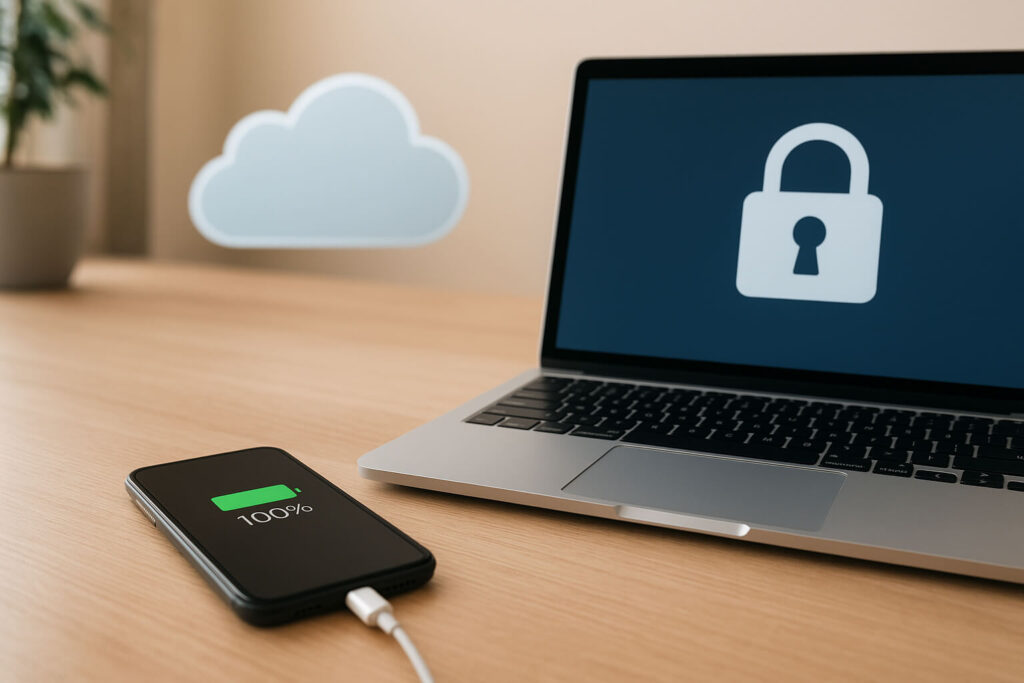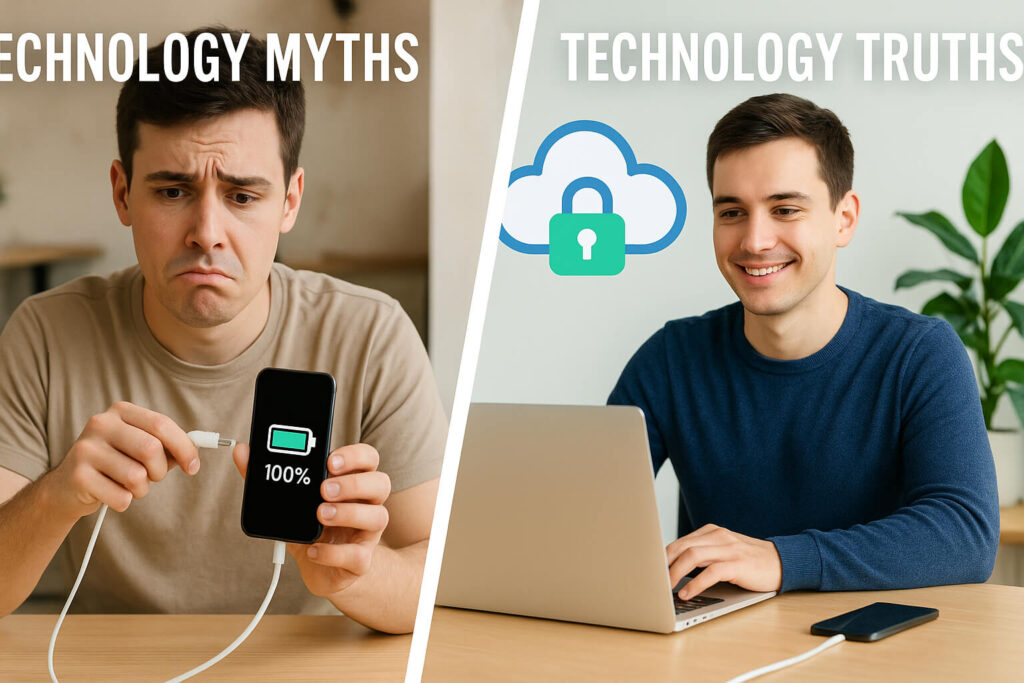Technology truths often hide behind persistent myths that shape our daily decisions about smartphone charging habits, cloud storage security, and digital privacy. These widespread misconceptions influence how millions of users interact with devices and make purchasing decisions worth thousands of dollars.
Walking into any coffee shop reveals these misunderstandings clearly. Someone frantically unplugs their phone at 100% battery. Another person refuses the free Wi-Fi, convinced it’s dangerous. These scenarios play out globally as well-meaning friends share outdated advice.
Let’s separate fact from fiction by examining the most persistent technology myths circulating today, backed by current research and real-world testing.
The Great Phone Battery Myth
Overnight Charging Damages Your Battery
Modern smartphones use lithium-ion batteries. These batteries include smart charging controllers. The controllers prevent overcharging automatically.
Your phone stops charging when it reaches 100%. The charging circuit switches to maintenance mode. This mode preserves battery health effectively.
Leaving phones plugged in overnight causes no damage. Battery manufacturers design devices for this behavior. Millions of users charge phones overnight safely.
Apple iPhones use optimized battery charging features. Samsung Galaxy devices implement adaptive charging technology. Google Pixel phones learn your charging patterns. These systems reduce battery aging significantly.
Battery degradation happens naturally over time. Chemical processes inside batteries slow gradually. Temperature fluctuations accelerate this aging process. Normal usage patterns cause minimal damage.
The real battery killers:
- Extreme temperatures harm batteries most
- Complete discharge cycles stress lithium-ion cells
- Cheap, non-certified chargers create problems
- Physical damage affects charging performance
- Using phones while fast charging generates heat
- Storing devices in hot cars damages cells permanently
Fast Charging Always Damages Batteries
Fast charging technology has evolved dramatically recently. Modern fast chargers communicate with devices directly. Smart charging protocols prevent overheating problems effectively.
Qualcomm Quick Charge adapts voltage levels dynamically. USB Power Delivery standards ensure safe charging. These technologies extend battery lifespan when implemented correctly.
Fast charging safety features:
- Temperature monitoring prevents overheating
- Voltage regulation maintains safe levels
- Current limiting protects battery cells
More Bars Mean Faster Internet
Signal bars display connection strength to cell towers. Connection strength doesn’t determine internet speed directly. Network congestion affects speed more significantly.
A tower with five bars might deliver slow speeds. Heavy traffic on that tower reduces performance. Meanwhile, a three-bar connection could provide faster internet.
Carrier networks use different frequency bands simultaneously. Lower frequencies travel farther distances. Higher frequencies provide faster speeds but shorter range.
Speed depends on multiple factors:
- Network congestion levels
- Tower technology (3G, 4G, 5G)
- Distance from broadcasting equipment
- Physical obstacles blocking signals
- Weather conditions affecting transmission
- Time of day usage patterns
Wi-Fi Signal Strength Equals Internet Performance
Wi-Fi signal bars show connection to your router. Router performance depends on internet plan speeds. A strong Wi-Fi signal can deliver slow internet.
Your internet service provider determines maximum speeds. Router age and technology limit wireless performance. Physical obstacles between devices cause connection issues.
Wi-Fi performance factors:
- Router placement in central locations
- Channel selection reduces interference
- Antenna positioning affects signal distribution
Privacy and Security Misconceptions
Incognito Mode Provides Complete Privacy
Browser incognito mode creates local privacy only. Your internet service provider sees all activity. Websites track visits through IP addresses. Government agencies monitor traffic when necessary.
Incognito mode prevents local storage of:
- Browsing history
- Downloaded files list
- Cookies and site data
- Form input information
Private browsing doesn’t hide activity from network administrators. School and workplace networks monitor traffic continuously. DNS requests reveal visited websites clearly. VPN services provide better privacy protection.
What incognito doesn’t hide:
- Your IP address from websites
- Activity from employers or schools
- Data from internet service providers
- Location tracking on mobile devices
- Browser fingerprinting techniques
- Social media tracking pixels
- Third-party analytics collection
- Advertising network surveillance
VPN Services Guarantee Complete Anonymity
Virtual Private Networks encrypt internet traffic effectively. However, VPN providers can log user activity. Some services cooperate with government requests. Free VPN services often sell user data.
Quality VPN providers implement no-logs policies. Independent audits verify these privacy claims. Jurisdiction matters for legal data requests.
VPN limitations include:
- DNS leaks revealing browsing activity
- Browser fingerprinting bypassing protection
- Payment methods linking accounts to identities
Public Wi-Fi Networks Are Safe Now
Modern encryption doesn’t eliminate all risks. Attackers create fake hotspots easily. These “evil twin” networks capture sensitive data.
Even legitimate networks pose threats. Other users might run malicious software. Network administrators could monitor traffic. Always use VPN services on public networks.
WPA3 encryption improves Wi-Fi security significantly. However, implementation varies between network providers. Older devices don’t support advanced encryption. Backward compatibility creates security vulnerabilities.
Public Wi-Fi dangers include:
- Man-in-the-middle attacks
- Malware distribution through networks
- Unencrypted data transmission
- Session hijacking attempts
- Fake captive portals stealing credentials
- Bluetooth attacks on nearby devices
- Social engineering through fake networks
- Eavesdropping on voice calls
Password Managers Create Single Points of Failure
Password managers actually reduce security risks overall. Using unique passwords for every account matters most. Master passwords protect encrypted vault data.
Leading password managers use zero-knowledge architecture. Companies cannot access your stored passwords. Multi-factor authentication adds security layers.
Password manager benefits:
- Generate complex unique passwords automatically
- Store passwords in encrypted vaults safely
- Alert users about compromised passwords quickly
Cloud Storage Myths Debunked
Cloud Storage Means Your Data Lives Elsewhere
Major cloud providers use distributed storage systems. Your files exist across multiple data centers simultaneously. Redundant copies ensure availability and security consistently.
Google Drive stores files in several locations globally. Amazon S3 replicates data automatically. Microsoft OneDrive maintains multiple backups continuously.
Data centers operate with enterprise-grade security measures. Physical access requires multiple authentication layers. Backup power systems ensure continuous operation.
Cloud storage benefits:
- Automatic backup protection
- Access from multiple devices
- Professional-grade security measures
- Disaster recovery capabilities
Cloud Services Always Keep Your Data Private
Cloud providers follow strict privacy regulations globally. However, terms of service allow data analysis. Government requests can access stored information.
End-to-end encryption protects sensitive data effectively. Zero-knowledge providers cannot access user content.
Privacy considerations:
- Service terms regarding data usage
- Government data access policies
- Third-party data sharing agreements
Free Cloud Storage Offers Unlimited Safety
Free services limit storage space and features. Paid plans provide better security options. Free accounts often lack advanced encryption. Customer support remains minimal for free users.
Free vs. paid differences:
- Storage capacity limitations
- File size upload restrictions
- Limited sharing permissions
- Reduced security features
Gaming and Entertainment Technology Myths
Gaming Mode Actually Improves Performance
Windows Game Mode optimizes system resources for gaming. Background processes receive lower priority automatically. However, performance improvements vary significantly between systems.
Modern computers often have sufficient resources already. Well-optimized games run smoothly without game mode. Gaming mode can sometimes reduce performance unexpectedly.
Game Mode effects:
- Reduces background task interference
- Prioritizes graphics processing resources
- May conflict with antivirus software operations
Higher Resolution Always Means Better Gaming
Display resolution affects visual clarity significantly. However, frame rate impacts gameplay more directly. Competitive gamers often prefer lower resolutions for higher refresh rates.
Graphics processing units struggle with high resolutions. 1440p provides excellent visual quality efficiently. Frame rate consistency improves gaming experience dramatically.
Artificial Intelligence and Smart Device Myths
Smart Home Devices Listen to Everything
Voice assistants activate on wake words only. Local processing occurs before cloud transmission. Privacy settings allow microphone disabling completely.
Physical mute buttons provide hardware-level control. Regular firmware updates improve security features.
Smart device privacy features:
- Wake word detection runs locally
- Privacy dashboards show data usage
- Deletion tools remove stored recordings
Social Media Security Myths
Deleted Posts Disappear Forever
Social platforms archive deleted content temporarily for legal compliance. Legal requirements mandate data retention periods globally. Cached versions exist on search engines indefinitely. Screenshots preserve controversial posts permanently online.
Facebook keeps deleted posts for 30-90 days minimum. Twitter maintains tweet archives indefinitely for research. Instagram stores deleted photos briefly for recovery. Google cache preserves public content for months.
Data deletion policies vary between platforms significantly. European GDPR requires genuine deletion eventually. However, backup systems complicate complete removal. Law enforcement can access archived content.
Digital footprints persist through:
- Platform backup systems
- Search engine caches
- Third-party archiving services
- User screenshots and saves
- Web archive organizations
- News media quotations
- Academic research databases
- Legal discovery processes
Social Media Algorithms Are Neutral
Platform algorithms optimize for user engagement primarily. Controversial content generates more interactions naturally. Algorithmic bias reflects training data patterns. Human moderators make subjective content decisions.
Machine learning systems amplify existing social biases. Training data contains historical discrimination patterns. Engineers cannot eliminate all algorithmic bias. Transparency reports reveal limited algorithm details.
Algorithm influence factors:
- Engagement metrics drive content promotion
- User behavior data shapes recommendations
- Advertiser preferences affect content visibility
- Political pressure influences moderation policies
Privacy Settings Guarantee Protection
Default privacy settings favor platforms over users. Companies change privacy policies regularly. New features often reset security preferences. Users must review settings periodically.
Privacy setting limitations:
- Platform policy changes override settings
- Data sharing with third parties continues
- Advertising profiles develop regardless
- Account deactivation doesn’t delete data
Hardware Performance Myths
More RAM Always Improves Performance
Computer performance depends on balanced components working together. Excessive RAM provides diminishing returns beyond certain thresholds. Bottlenecks often occur elsewhere in systems.
A fast processor needs adequate RAM to function optimally. However, upgrading from 16GB to 32GB rarely improves everyday computing tasks. Slow storage limits overall performance more than RAM shortages.
Performance factors beyond RAM:
- Processor speed and core count
- Storage type (SSD vs. HDD)
- Graphics card capabilities
- System cooling efficiency

Expensive Cables Always Provide Better Quality
Digital signals work differently than analog connections. HDMI cables either transmit perfect signals or fail completely. Expensive cables don’t improve picture quality beyond basic functionality.
Build quality affects longevity and reliability. Cheap cables use inferior materials. Poor shielding causes interference in some environments.
When cable quality matters:
- Long distance connections over 15 feet
- High interference environments
- Frequent plugging requirements
Macs Never Get Viruses
Apple computers face fewer threats historically due to market dynamics. Windows systems present larger target audiences for cybercriminals. However, Mac malware exists and increases yearly as adoption grows.
The macOS security model includes several protective layers. Gatekeeper prevents unauthorized software installation. System Integrity Protection limits system modifications.
Recent Mac threats demonstrate evolving attack methods:
- Cryptocurrency mining malware draining system resources
- Adware targeting Safari users specifically
- Social engineering scams exploiting user trust
Mac security requires proactive measures:
- Regular software updates from Apple
- Antivirus software installation and maintenance
- Cautious download habits from trusted sources
- Email attachment verification processes
Internet Speed and Connectivity Myths
Faster Internet Always Improves Experience
Application requirements vary significantly across different services. Streaming 4K video needs consistent speeds rather than peak performance. Email requires minimal bandwidth usage. Online gaming prioritizes low latency over raw speed.
Understanding bandwidth requirements prevents overspending on internet plans. Netflix recommends 25 Mbps for 4K streaming per device. However, most households rarely use maximum speeds simultaneously.
Bandwidth needs by activity:
- Email and web browsing: 1-3 Mbps sufficient
- HD video streaming: 5-10 Mbps required per stream
- 4K streaming with HDR: 25 Mbps minimum
- Online gaming: 3-6 Mbps with low latency requirements
Internet Speed Tests Show Real Performance
Speed test results represent ideal conditions rarely experienced daily. Test servers optimize for maximum throughput measurements. Real-world usage involves multiple devices sharing bandwidth.
Internet service providers sometimes prioritize traffic to speed test servers. Independent testing reveals actual performance more accurately.
Factors affecting real performance:
- Network congestion during peak hours
- Wi-Fi interference from neighboring networks
- Background applications consuming bandwidth automatically
Ethernet Cables Don’t Make Differences
Cable quality affects signal integrity directly. Cheap cables introduce interference problems. Proper shielding reduces electromagnetic noise. Category ratings indicate performance capabilities.
Ethernet cable differences:
- Cat5e: Up to 1 Gbps speeds
- Cat6: Up to 10 Gbps with limits
- Cat6a: 10 Gbps at full distance
- Cat7: Advanced shielding options
Mobile Technology Misconceptions
Closing Apps Saves Battery Life
Modern operating systems manage memory efficiently. iOS and Android suspend unused applications. Force-closing apps actually wastes battery power. The system must reload applications repeatedly.
Battery saving strategies that work:
- Reduce screen brightness levels
- Disable location services selectively
- Turn off background app refresh
- Use low power modes when available
Generic Phone Chargers Work Identically
Charger specifications vary between manufacturers significantly. Voltage and amperage differences affect charging. Poor quality chargers damage devices over time. Certified accessories ensure safe operation.
Charger safety considerations:
- Voltage compatibility requirements
- Current delivery specifications
- Safety certification standards
- Cable quality and durability
Software and Operating System Myths
Regular Restarts Aren’t Necessary Anymore
Modern systems still benefit from periodic restarts. Memory leaks accumulate over time gradually. Background processes consume resources continuously. Security updates require restart activation.
Restart benefits include:
- Memory cleanup and optimization
- Process termination and refresh
- System update installation completion
- Hardware driver reinitialization
Antivirus Software Slows Computers Down
Quality antivirus programs optimize system performance. Real-time protection uses minimal resources efficiently. Poor antivirus choices create performance problems. Free solutions often lack optimization features.
Choosing effective antivirus:
- Independent lab test results
- System resource usage metrics
- Feature completeness evaluation
- Customer support quality assessment
Data Recovery and Backup Myths
Deleted Files Cannot Be Recovered
File deletion removes directory entries only. Actual data remains on storage devices. Recovery software can restore deleted files. Secure deletion requires special overwriting procedures.
File recovery factors:
- Time since deletion occurred
- Disk usage after deletion
- Storage device type used
- Recovery software capabilities
One Backup Copy Provides Sufficient Protection
Technology professionals recommend multiple backup copies. The 3-2-1 rule ensures comprehensive protection. Three copies of data minimize risks. Two different media types prevent failures. One off-site backup protects against disasters.
Backup strategy components:
- Local backup for quick access
- Cloud backup for off-site protection
- Archive backup for long-term storage
- Regular backup testing procedures
Conclusion
Technology truths reveal that common myths mislead users daily about digital security, device performance, and online privacy. Understanding these misconceptions helps make informed decisions consistently.
The technology landscape changes rapidly every year. Battery technology improves with each smartphone generation. Security threats evolve alongside protection measures.
Smart technology choices require separating fact from fiction consistently. Question popular beliefs about smartphones, internet security, and computer performance carefully. Research claims before making important technology purchases.
Critical thinking applies to technology advice especially. Social media spreads misinformation rapidly nowadays. Independent testing provides objective performance data.
Staying informed requires:
- Following reputable technology news sources
- Reading independent product reviews regularly
- Testing claims personally when possible
- Understanding basic technology principles
Consumer education empowers better technology decisions ultimately. Share accurate information to combat widespread misconceptions.
These technology truths empower users to navigate our digital world more safely and effectively. Understanding reality behind common myths prevents costly mistakes and security breaches. The digital age requires continuous learning and informed decision-making for optimal technology experiences.
FAQs About Technology Myths
1. Does charging my phone overnight really damage the battery?
Nope, that’s an old myth. Modern smartphones use smart charging systems that stop the current once your phone hits 100%. What actually hurts batteries is extreme heat, using sketchy chargers, or letting them fully drain often. So relax—plugging in overnight is perfectly safe for most people’s daily routine.
2. Is incognito mode the same as being anonymous online?
Not at all. Incognito only hides your browsing history from others on the same device. Your internet provider, employer, and even websites still see your activity. Think of it as pulling the curtains in your room—not moving to a secret location. For real privacy, you’d need tools like a VPN.
3. Are Macs really immune to viruses?
That’s wishful thinking. While Macs historically faced fewer attacks than Windows, malware for macOS is growing. Cybercriminals go where users are, and Apple’s popularity makes it a bigger target now. Good security habits—like software updates and cautious downloads—are just as necessary on Macs as they are on PCs.
4. Does closing apps on my phone actually save battery?
Surprisingly, no. iOS and Android are built to pause unused apps so they don’t drain much power. Constantly swiping them away forces your phone to reload them, which actually uses more energy. If you want longer battery life, focus on brightness, background refresh, and location settings instead.
5. Do expensive HDMI or charging cables improve performance?
Not really. Digital signals work like light switches: they either make it through cleanly or they don’t. A $10 HDMI cable will give you the same picture as a $100 one. What you’re really paying for is durability and build quality—not better image or charging performance.
Also read:
The Rise of Voice Technology: How AI Is Changing the Way We Talk to Machines


